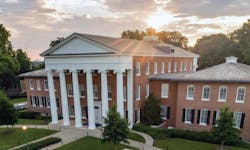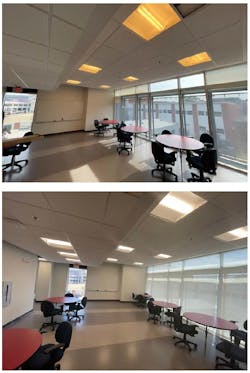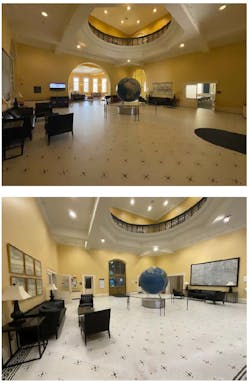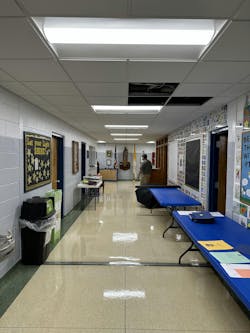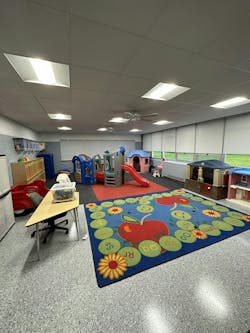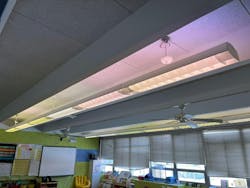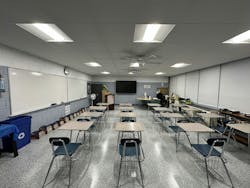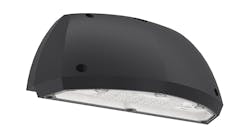The University of Mississippi (known as “Ole Miss”) and St. Augustine Catholic School are vastly different educational institutions. Yet they each recently embarked upon an LED lighting project with similar goals in mind: Reduce energy consumption while improving illumination quality.
Ole Miss is a 180-year-old public university that serves more than 17,000 undergraduate students on a sprawling 3,500-acre campus in Oxford, Mississippi. St. Augustine is a 65-year-old private school that serves about 200 pre-kindergarten through eighth grade students in a single building located behind the school’s affiliated 111-year-old stone church in Richmond, Michigan.
Despite their differences, the two schools faced similar issues related to outdated and inconsistent lighting. Ole Miss’s lighting system included varying fixture and lamp types among different buildings and even within the same buildings. St. Augustine’s lighting system included fluorescent lamps of varying color temperatures within the school’s original T12 linear fixtures.
In both cases, the lighting systems were inconducive to the needs of an educational setting, where lighting has been shown to have a measurable impact on comfort and learning. But both schools wanted to do more than simply provide effective illumination; they also wanted to conserve energy. Here’s how they each went about it.
Lighting as a strategic measure
Ole Miss’s lighting project is the first phase of a larger capital improvement program focused on energy conservation. The university issued an RFP for an energy-savings performance contract (ESPC) and awarded it to Trane, a building technology and energy solutions company. Trane began working on the lighting project in April 2023 and is set to deliver the program’s subsequent phases.
According to Dean Hansen, director of facilities management at Ole Miss, the university started with lighting because it generates significant savings in a relatively short period of time. In fact, the contract with Trane guarantees an annual energy-based savings of $690,000 — money the university will use to cover other stages of the program, which will include mechanical upgrades and building envelope conservation measures.
The later phases of the program “don’t have the same payback that lighting does, and if they were to stand on their own, they may not pay themselves back in the 20 years that we’re allowed to execute one of these contracts,” Hansen said, referring to the state’s ESPC requirements. “The LED lighting project helps the total program pay back within the 20 years.”
To reap the savings, the university is upgrading 49,000 lighting fixtures in 94 administrative and classroom buildings — many of which are over 100 years old and feature varying light levels and colors throughout. According to Mike Dunnavant, associate director of facilities operations at Ole Miss, the team is following the Illumination Engineering Society’s recommended lighting levels for offices, corridors, and classrooms to achieve adequate and consistent illumination along with energy savings.
With this in mind, the team is using 2×4, 2×2, and 2×1 Cooper Lighting CBRK Cruze retrofit fixtures throughout campus. Green Creative SelectFit downlights with DualDim technology were also used to replace previous recessed cans. In addition to energy savings, the choice brings other sustainability advantages, starting with product packaging. According to Joey Shackelford, lead project manager for Trane, the team worked with the lighting manufacturer to package the thousands of fixtures in a way that resulted in a roughly 70% reduction in corrugated cardboard and packing material needs.
Another sustainability advantage comes from the product itself. As a retrofit kit, the CBRK Cruze is an inlay that works with the university’s existing lighting troffers, explained Ellen Helm, energy services portfolio director for Trane. “We’re using the existing structure that was there and just replacing that one part of the fixture where the LEDs are,” she said. “That’s the big play from a recyclability and a sustainability standpoint, and it’s cheaper as well.”
The university expects the switch from fluorescents to LEDs to generate other savings, too — from reduced heat loads on its buildings to less maintenance. With about 85% of the project completed, the university is already seeing an impact. According to Dunnavant, the maintenance team has spent less time carrying ladders through buildings to change tubes than they did before. “We’ve eliminated a lot of safety issues, and we’ve eliminated a lot of time spent on changing tubes,” he said.
In addition to the sustainability aspects, the project is also creating learning opportunities for students. More than a dozen Ole Miss mechanical engineering students have focused their senior capstone projects on the lighting project and other components of the capital improvement program. The students are working directly with the Trane team on their projects, the results of which are helping to inform actual improvements to the school’s facilities, according to Nancy McBee, business development manager at Trane. “We actually hired one of the capstone students because we were so impressed with her,” she said.
With all that the project is achieving, the team reports that faculty and staff are overwhelmingly pleased with the light quality and efficiency results thus far. The only reported issues have related to the Lutron occupancy sensors that the team installed in offices and classrooms as a visual reinforcement of the importance of energy savings. Sometimes, the sensors turn the lights off when individuals are sitting still at their desks, forcing them to wave their arms or take other actions to turn them back on, Hansen explained. (Editor's note: This is common with some simple occupancy sensors. Indeed, LEDs Magazine notes a similar occurrence in one of its satellite offices from time to time.)
If they had to do it over again, Hansen said, the team would have left the sensors out. “There isn’t a lot of savings that get generated by putting occupancy sensors in offices and classrooms just because the cost of operating those lights is so much less than it was before. But for an optics and public relations point of view, we opted to include them in a lot of our spaces,” he said. “We’re actually paying more to put those in than we’re probably going to save by using the controls.”
As the lighting project wraps up this spring, the university looks forward to leveraging the related cost savings to fund the remainder of the capital improvement program — advancing the university’s operational goals. “In the state of Mississippi, we’re viewed as a leader in this area amongst the higher education institutions in the state,” Hansen said. “That’s where we want to be everywhere, not just in sustainability and energy savings, but in all aspects of our operations.”
Lighting for higher learning
Meanwhile, in the greater Detroit region, St. Augustine Catholic School partnered with EarthTronics, an LED lighting manufacturer in Norton Shores, Michigan, to upgrade its outdated lighting system. Original to the school, the system featured two rows of T12 linear fixtures with fluorescent lamps mounted to exposed tectum ceilings in 16 classrooms and the school library.
While the system remained largely unchanged since the school opened in 1959, school officials replaced the lamps with several types of tubes over time. As a result, the building featured inconsistent color temperatures throughout, creating an unattractive and inefficient learning environment, according to a report from EarthTronics executive vice president Kevin Youngquist.
With studies showing that poor and uneven lighting can interfere with reading and concentration, can lead to long-term visual impairment, and can exacerbate hyperactivity, school administrators knew they needed to update the system to benefit students and teachers. According to the report, they wanted a system that provided a higher lumen output and consistent color temperature with aesthetically pleasing fixtures, while achieving energy efficiency goals.
The school’s specification review team, which included parishioner and electrician Chris Shinska and lighting specialist and manufacturer representative John Monkowski, studied various lighting options and decided that a system with 2×2 and 2×4 LED troffers in a drop-ceiling arrangement would work best. From there, the team reviewed different manufacturers, and according to the report, selected EarthTronics troffers for their low profile and color and wattage adjustment capabilities.
For the 2×2 grid ceiling, the team opted for dual-channel troffers with lighting controls that offer white color tuning at 3500K, 4000K, and 5000K with 82 CRI and 0–10V continuous dimming drivers that deliver flicker-free illumination. At the time of installation, these fixtures can be set at 20, 25, or 30W while the 2×4 troffers can be set to 25, 30, or 35W. The St. Augustine team set the luminaires at 30 and 35W and 5000K to maximize visual acuity. “The LED troffers deliver more even lighting, consistent color temperature, better spacing, less hotspots, and more lumens,” Monkowski said in the report.
Even though the team set the lights at the maximum wattage, with 125 lm/W efficacy significant energy savings are achieved. “The old lighting system had 48 T12 fluorescent tubes that consumed 40W each for a total of 1,920W,” Monkowski said. “We replaced them with nine EarthTronics 2×2 LED troffers in each classroom. Since each one consumed 30W, the total consumption per classroom was reduced to 270W. That is a dramatic savings of 1,650W in each classroom.”
The team worked on the project over the summer of 2023 and completed it in time for the first day of school. According to the report, it has elicited positive reactions from teachers and others in the St. Augustine community.
“The teachers are ecstatic about the look of the new classrooms,” Monkowski said. “And the lighting system helped make a better presentation of the school to prospective students and parents because the classrooms now look modern and well lit. Overall, the new lights create a more welcoming look and much [more functional] learning environment, which benefits our students and instructors.”
JENNY JONES is an award-winning freelance writer based in Northern Virginia. She has more than 20 years of editorial experience and specializes in making complex subjects clear and engaging.
*Updated April 2, 2024 for Trane description and link.
*Updated April 11, 2024 for sensor clarification.
Follow our LinkedIn page for our latest news updates, contributed articles, and commentary, and our Facebook page for events announcements and more. You can also find us on the X platform.
